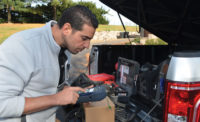There’s no such thing as magic in hydronics. There are no magic boilers, controls, or circulators that know what to do. If someone can’t explain to you exactly how a delta (Δ) P or a ΔT variable-speed circulator works, and why, without using the word “magic” or some derivative thereof, there’s one hydronics expert I know who says, “They either went to hydronics school at Hogwarts, or they don’t really know.”
That expert is Taco Inc.’s training pro, and The NEWS’ 2015 Best Trainer, John Barba. I’ve learned a lot about hydronics from him and my local rep, Anthony Reikow, through the years.
So, to polish my familiarity with the art of hydronics, and to equip myself with the terms necessary to better explain it to others — and you — I occasionally pick up the phone or email Barba. Or, better yet, I visit with him while he’s training in the field or at Taco’s facility in Cranston, Rhode Island.
Einstein once said, “If you can’t explain it simply, then you don’t understand it well enough.” I love hydronics and am now developing — thanks to great guidance and a lot of on-the-job-training and field experience — an intuitive sense of understanding. As the great Dan Holohan says, “Be the water.”
DECIPHERING THE DELTAS
While I’m gradually getting better at being the water, I still have a hard time explaining what I know. So, when it came to the topic of how ΔT and ΔP circulators work and when it’s best to use either one of them, I touched base with my trusty friend, Barba.
“There’s no such thing as ‘push the button and walk away’ with any variable-speed circulator, no matter what sales people may tell you,” he said. “Ha. In fact, you may find yourself having to ‘walk back.’”
Now I’m laughing, too. That’s another pleasant advantage of talking with John; he makes you laugh — all the time.
ΔT
According to Barba, ΔT is easy to grasp, in concept. When you design a hydronic system, you always calculate flow rate around a ΔT, or temperature drop, between the supply and return. This little factoid is found in the ages-old Universal Hydronics Formula, which states:
Gallons per minute (GPM) = Btuh ÷ (ΔT × 500).
• Btuh is the heating load you’re trying to satisfy at a given point in time;
• ΔT is the designed-for fluid temperature drop as it goes round the system;
• 500 is a constant when using 100 percent water. Glycol changes things; and
• We tend to use a 20°F ΔT when designing residential hydronic systems here in North America.
If we know the heating load, and we know the ΔT we’re designing for, finding the required flow rate is simple math:
Gpm = 70,000 ÷ (20 × 500)
Gpm = 70,000 ÷ 10,000
Gpm = 7
Now, Barba’s warming up, and I’m doing my best to keep pace with him.
He’s telling me that in order to deliver 70,000 Btuh to this structure at a 20° ΔT, I’ll need a flow rate of 7 gpm.
And, now, knowing the flow rate, I can calculate the head loss as best I can through the rest of the system. When I know the flow and head requirements, I can go about selecting a circulator that will deliver that flow and overcome that head loss.
Now, please note there’s not a circulator in the world that can be thrown into that application and just figure it out, said Barba.
The term “smart pump” is really inaccurate because none of them are all that smart. No machine can — or should — replace your experience and knowledge when it comes to accurately selecting a circulator, no matter what other manufacturers might say. Machines aren’t ready to take over the world just yet.
We, the installers/designers, should be the brains of this operation. If we select a ΔT variable-speed circulator, we’ll need to do three things, none of which are very difficult, but all of which are essential:
1. Make sure the circulator can handle the maximum flow and head requirements. If it’s not big enough, it’s not big enough;
2. Make sure the circulator is programmed for the designed-for ΔT. Taco ΔT circs are factory set for a 20° ΔT, since that’s what we use most in North America, but it’s easy to change, if necessary, based on the application; and
3. Install the supply and return temperature sensors in the appropriate locations.
“On an initial call for heat, the circulator will run at full speed for a certain amount of time to establish a temperature difference,” said Barba, explaining how a ΔT variable-speed works. “It will continue until it establishes that 20° temperature difference between the supply and return.”
In the above example, if all zones were calling at design temperature, the load would be 70,000 Btuh. In order to deliver the 70,000 Btuh and maintain that 20° ΔT, the circulator would have to provide 7 gpm, presuming your heat loss is dead-on accurate (which it rarely is, but this is an example).
As zone valves close, common sense says the actual Btuh load of the system will be lower. Since the system is taking less heat out of the fluid, the return sensor will pick up an increase in the return water temperature as the system’s ΔT starts to shrink. The logic written into the circulator control takes over and slows the circulator down in order to restore that 20° ΔT. When zone valves open, it does the opposite.
The same thing happens when the outdoor temperature changes. When it’s colder out, the system takes more energy out of the fluid. In order to maintain the 20° ΔT, the circulator will have to go faster. When it’s warmer out, the opposite occurs, and the circulator will go slower.
ΔP
As many of you know, Taco now offers both ΔT and ΔP variable-speed residential circulators made right here in the U.S. So, to the notion that Europeans are the holders of all hydronic knowledge, and because that’s where ΔP circs are broadly used, that doesn’t mean they’re not best-suited for use here.
ΔP circs were developed by Europeans for the type of hydronic system most common in Europe — panel radiators with thermostatic radiator valves (TRVs).
The circulator in that type of system runs all the time while the TRVs modulate to regulate flow through the radiator and, hopefully, relative comfort in the room. There are no thermostats.
ΔP works great in that application, and there are U.S.-made circs created precisely for that job. But, the cold, hard reality is, we don’t install that many of those systems over here.
“In North America, we use either zone pumps or zone valves,” said Barba. “And, we do something really kooky and crazy. When zones are satisfied, we turn the pump off. That’s nuts, huh?”
Barba goes on to explain that ΔP circs work just fine in these zoned, on-off systems. But, when used as a zone pump, it’ll never vary its speed. ΔP changes speed based on resistance against the impeller typically caused by modulating TRVs. So, what you have is a ΔP, fixed-speed pump. Yes, it’s an efficient electronically commutated motor (ECM) pump, but it will only ever run at one speed.
ΔT, on the other hand, is designed for use as a zone pump or with zone valves — the types of systems we install here in North America. In either application, it’s a variable-curve circulator, meaning the curve will vary and the circulator will speed up and slow down to maintain the designed-for ΔT in the system.
The circulator changes speeds as zones open or close and as the heating load changes with the weather. In addition, when programmed to, say, a 20° ΔT, the circulator will virtually always send 20° cooler water back to the boiler. That has a tremendous impact on boiler short-cycling and enhances overall system efficiency, not just electrical consumption.
What I’ve found, time and time again, is that ΔT circs, and pumping strategies built around this type of pump, are an outstanding choice for anyone who wants to maximize the overall efficiency of any system.
And, no — I don’t believe in magic.
Publication date: 1/25/2016
Want more HVAC industry news and information? Join The NEWS on Facebook, Twitter, and LinkedIn today!











Report Abusive Comment